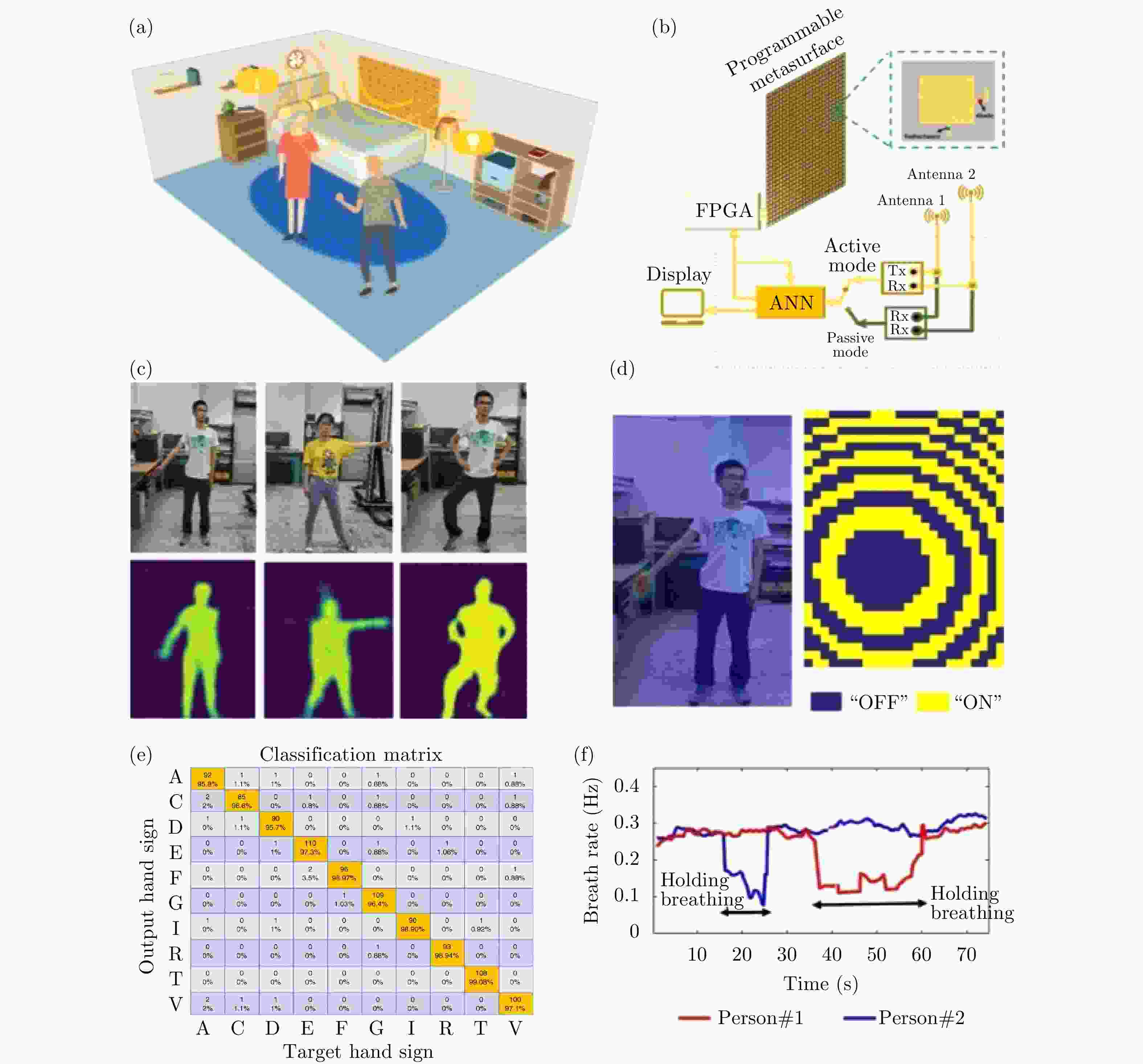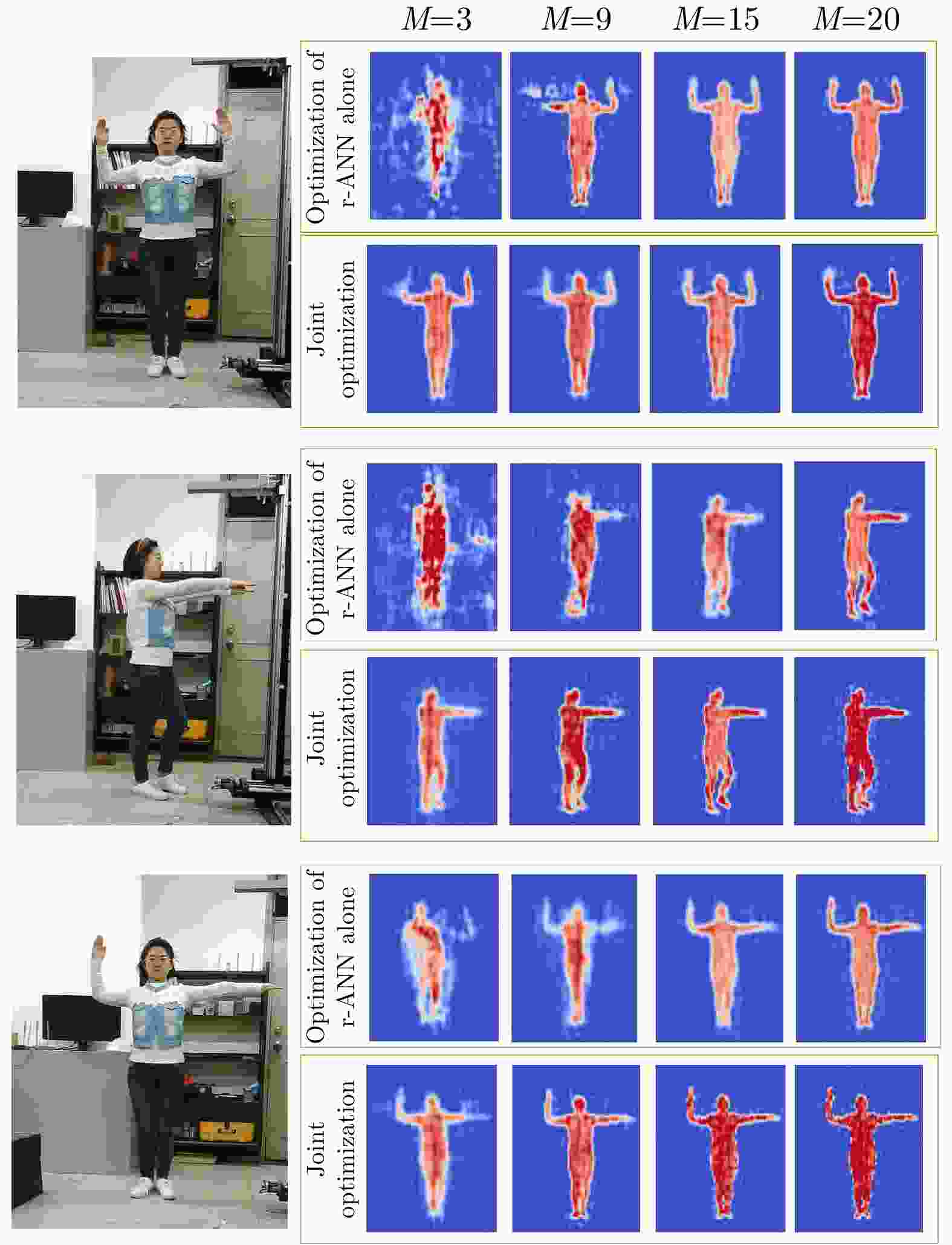-
摘要: 智能电磁感知是电磁探测与成像的系统化和智能化延伸,是安全检查、生物医学、物联网等领域的基础性、关键性和共性问题。近年来,挖掘利用人工电磁材料和人工智能在电磁波调控与数据信息调控方面的强大能力,将其有机结合,并系统地引入电磁感知领域,发展了低成本、高性能的智能电磁感知体制,为电磁感知的进一步发展提供了关键理论和技术支撑。该文讨论了智能电磁感知的若干最新进展,为读者及时掌握该领域的最新进展提供有益帮助。Abstract: Intelligent electromagnetic sensing, which is based on electromagnetic imaging, aims to realize the real-time and smart imaging and recognition of objects of interest. Thus, intelligent electromagnetic sensing has been applied in many areas, including science, engineering, and the military. Recently, we explored the unique capabilities of artificial intelligence and artificial materials in the flexible manipulation of electromagnetic information and electromagnetic wavefields, respectively. Further, we developed several interesting schemes for intelligent electromagnetic sensing by fully incorporating artificial intelligence with artificial materials, particularly information metamaterials. Thus, several intelligent electromagnetic sensing systems, which exhibit interesting properties, like low hardware cost and high efficiency, have been developed. The proposed sensing strategies are expected to pave the way for wireless communications, smart homes, and other future applications.
-
图 1 首个可编程数字编码超材料的基本概念和部分结果[13]
(a)1比特相移键控可编程数字编码超材料示意图 (b)1比特相移键控可编程数字编码超材料的单元结构及其相位-频率响应曲线 (c)1比特相移键控可编程数字编码超材料的在波束扫描中的若干应用 (d)1比特相移键控可编程数字编码超材料的基本工作原理
Figure 1. Concepts and Results of the first programmable digital coding metamaterials[13]
(a) The schematic diagram of 1-bit phase-shift programmable digital coding metamaterial (b) The element structure of 1-bit phase-shift programmable digital coding metamaterial and its phase frequency characteristic curves (c) 1-bit phase-shift programmable digital coding metamaterial in beam scanning applications (d) The basic working principle of 1-bit phase-shift programmable digital coding metamaterial
图 3 经典机器学习驱动的智能电磁感知成像原理和部分结果[24]
(a)主分量机器学习方法驱动的智能电磁感知的工作原理示意图 (b)基于2比特信息超材料的智能电磁感知系统示意图 (c)2比特相移键控信息超材料及单元结构示意图 (d)不同成像人体目标的光学图片 (e)基于主分量机器学习驱动智能电磁感知的成像结果 (f)基于随机降维机器学习驱动智能电磁感知的成像结果
Figure 3. The imaging principle and results of intelligent electromagnetic sensing driven by classical machine learning[24]
(a) The schematic diagram of the principle of intelligent electromagnetic sensing driven by principal component machine learning (b) The schematic diagram of intelligent electromagnetic sensing system based on 2-bit information metamaterial (c) The schematic diagram of 2-bit phase-shift information metamaterial and element structure (d) The optical images of different human targets (e) The imaging results of intelligent electromagnetic sensing driven by principal component machine learning (f) The imaging result of intelligent electromagnetic sensing driven by machine learning based on random dimension reduction
图 4 深度学习驱动的智能电磁感知成像原理和部分结果[25]
(a)智能电磁感知的工作原理示意图 (b)基于1比特信息超材料的智能电磁感知系统示意图 (c)不同成像人体目标的光学图片及其成像结果 (d)基于智能感知系统的感兴趣人体局部姿势的波束聚焦结果 (e)基于智能感知系统的10个英文字母的手语识别结果 (f)基于智能感知系统的2个人体的呼吸特征识别结果
Figure 4. The imaging principle and results of intelligent electromagnetic sensing driven by deep learning[25].
(a) The schematic diagram of working principle of intelligent electromagnetic sensing (b) The schematic diagram of intelligent electromagnetic sensing system based on 1-bit information metamaterial (c) Optical images of different human targets and corresponding imaging results (d) The beam focusing on interested human local posture based on intelligent sensing system (e) The sign language recognition results of 10 English letters based on intelligent sensing system (f) The recognition results of respiratory characteristics for two persons based on intelligent perception system
图 5 数据获取和处理一体化的智能电磁感知成像原理图[28]
(a)基于1比特信息超材料智能电磁感知的工作原理示意图 (b)和(c)算法原理示意图
Figure 5. The schematic diagram of intelligent electromagnetic sensing integrated with data acquisition and processing[28]
(a) The schematic diagram of working principle of intelligent electromagnetic sensing based on 1-bit information metamaterial (b) and (c) The schematic diagram of proposed algorithm
-
[1] SMITH D R, PADILLA W J, VIER D C, et al. Composite medium with simultaneously negative permeability and permittivity[J]. Physical Review Letters, 2000, 84(18): 4184–4187. doi: 10.1103/PhysRevLett.84.4184 [2] PENDRY J B. Negative refraction makes a perfect lens[J]. Physical Review Letters, 2000, 85(18): 3966–3969. doi: 10.1103/PhysRevLett.85.3966 [3] SHELBY R A, SMITH D R, and SCHULTZ S. Experimental verification of a negative index of refraction[J]. Science, 2001, 292(5514): 77–79. doi: 10.1126/science.1058847 [4] PENDRY J B, SCHURIG D, and SMITH D R. Controlling electromagnetic fields[J]. Science, 2006, 312(5781): 1780–1782. doi: 10.1126/science.1125907 [5] SCHURIG D, MOCK J J, JUSTICE B J, et al. Metamaterial electromagnetic cloak at microwave frequencies[J]. Science, 2006, 314(5801): 977–980. doi: 10.1126/science.1133628 [6] MA Huifeng and CUI Tiejun. Three-dimensional broadband ground-plane cloak made of metamaterials[J]. Nature Communications, 2010, 1(3): 21. [7] JIANG Weixiang, CUI Tiejun, YANG Xinmi, et al. Shrinking an arbitrary object as one desires using metamaterials[J]. Applied Physics Letters, 2011, 98(20): 204101. doi: 10.1063/1.3590203 [8] MA Huifeng and CUI Tiejun. Three-dimensional broadband and broad-angle transformation-optics lens[J]. Nature Communications, 2010, 1: 124. doi: 10.1038/ncomms1126 [9] YU Nanfang, GENEVET P, KATS M A, et al. Light propagation with phase discontinuities: Generalized laws of reflection and refraction[J]. Science, 2011, 334(6054): 333–337. doi: 10.1126/science.1210713 [10] AIETA F, GENEVET P, YU Nanfang, et al. Out-of-plane reflection and refraction of light by anisotropic optical antenna metasurfaces with phase discontinuities[J]. Nano Letters, 2012, 12(3): 1702–1706. doi: 10.1021/nl300204s [11] KHORASANINEJAD M, CHEN Weiting, DEVLIN R C, et al. Metalenses at visible wavelengths: Diffraction-limited focusing and subwavelength resolution imaging[J]. Science, 2016, 352(6290): 1190–1194. doi: 10.1126/science.aaf6644 [12] CONG Longqing, PITCHAPPA P, LEE C, et al. Active phase transition via loss engineering in a terahertz MEMS metamaterial[J]. Advanced Materials, 2017, 29(26): 1700733. doi: 10.1002/adma.201700733 [13] CUI Tiejun, QI Meiqing, WAN Xiang, et al. Coding metamaterials, digital metamaterials and programmable metamaterials[J]. Light: Science & Applications, 2014, 3(10): e218. [14] CUI Tiejun, LIU Shuo, and ZHANG Lei. Information metamaterials and metasurfaces[J]. Journal of Materials Chemistry C, 2017, 5(15): 3644–3668. doi: 10.1039/C7TC00548B [15] CUI Tiejun, LIU Shuo, and LI Lianlin. Information entropy of coding metasurface[J]. Light: Science & Applications, 2016, 5(11): e16172. [16] CUI Tiejun. Microwave metamaterials–from passive to digital and programmable controls of electromagnetic waves[J]. Journal of Optics, 2017, 19(8): 084004. doi: 10.1088/2040-8986/aa7009 [17] LI Lianlin and CUI Tiejun. Information metamaterials-from effective media to real-time information processing systems[J]. Nanophotonics, 2019, 8(5): 703–724. doi: 10.1515/nanoph-2019-0006 [18] MA Qian and CUI Tiejun. Information metamaterials: Bridging the physical world and digital world[J]. PhotoniX, 2020, 1(1): 1. doi: 10.1186/s43074-020-00006-w [19] CUI Tiejun, LI Lianlin, LIU Shuo, et al. Information metamaterial systems[J]. iScience, 2020, 23(8): 101403. doi: 10.1016/j.isci.2020.101403 [20] LIU Shuo, CUI Tiejun, ZHANG Lei, et al. Convolution operations on coding metasurface to reach flexible and continuous controls of terahertz beams[J]. Advanced Science, 2016, 3(10): 1600156. doi: 10.1002/advs.201600156 [21] SHUANG Ya, ZHAO Hanting, JI Wei, et al. Programmable high-order OAM-carrying beams for direct-modulation wireless communications[J]. IEEE Journal on Emerging and Selected Topics in Circuits and Systems, 2020, 10(1): 29–37. doi: 10.1109/JETCAS.2020.2973391 [22] LI Lianlin, CUI Tiejun, JI Wei, et al. Electromagnetic reprogrammable coding-metasurface holograms[J]. Nature Communications, 2017, 8(1): 197. doi: 10.1038/s41467-017-00164-9 [23] CUI Tiejun, LIU Shuo, BAI Guodong, et al. Direct transmission of digital message via programmable coding metasurface[J]. Research, 2019, 2019: 2584509. [24] LI Lianlin, RUAN Hengxin, LIU Che, et al. Machine-learning reprogrammable metasurface imager[J]. Nature Communications, 2019, 10(1): 1082. doi: 10.1038/s41467-019-09103-2 [25] LI Lianlin, SHUANG Ya, MA Qian, et al. Intelligent metasurface imager and recognizer[J]. Light: Science & Applications, 2019, 8: 97. [26] LI Lianlin, WANG Longgang, TEIXEIRA F L, et al. DeepNIS: Deep neural network for nonlinear electromagnetic inverse scattering[J]. IEEE Transactions on Antennas and Propagation, 2019, 67(3): 1819–1825. doi: 10.1109/TAP.2018.2885437 [27] ZHAO Hanting, SHUANG Ya, WEI Menglin, et al. Metasurface-assisted massive backscatter wireless communication with commodity Wi-Fi signals[J]. Nature Communications, 2020, 11(1): 3926. [28] LI Haoyang, ZHAO Hanting, WEI Menglin, et al. Intelligent electromagnetic sensing with learnable data acquisition and processing[J]. Patterns, 2020, 1(1): 100006. doi: 10.1016/j.patter.2020.100006 -



 作者中心
作者中心 专家审稿
专家审稿 责编办公
责编办公 编辑办公
编辑办公

 下载:
下载:







